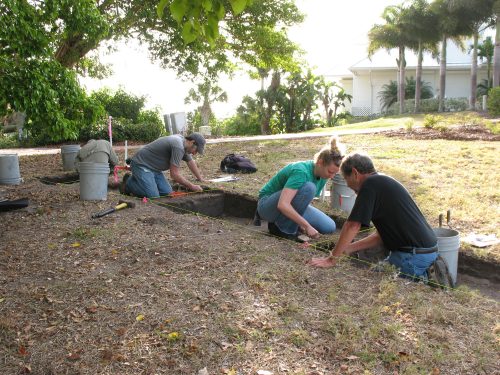In late November, we will return to Useppa Island to resume work in deposits that accumulated there about 3,000 years ago. This work is co-sponsored by the Florida Museum of Natural History’s Randell Research Center (RRC), the Useppa Island Historical Society, and the Useppa Inn and Dock Company.

Marquardt. Photo by K. Walker
We are grateful to Tim Fitzsimmons and Garfield Beckstead of Useppa Island for providing the logistical assistance, lodging, and boat transportation that makes this work possible, and to David and Judy Nutting for permission to work on their property.
This work will continue a project initiated in March, 2012, when Useppa residents joined with volunteers from the RRC and archaeologists from the Florida Museum to explore part of Useppa’s Southern Ridge (known locally as the “South Knoll”).
One of the most common questions that Useppa passers-by asked us in March was, “Why are you digging at this particular place?” Well, it is not the oldest deposit on Useppa, nor are we fi nding extraordinary artifacts, but we do think the deposits left there by ancient Native Americans may help us fill in gaps in our understanding of climate changes and how the Indian people adapted to them. This, to us, is quite exciting.
Although we had the opportunity in 2006 to study a cut-away of Archaic midden on nearby Lot III-17 (again thanks to the generous support of David Nutting), that was a salvage project (see RRC News, March 2007). We documented what remained after the destruction of a portion of an archaeological midden. After drawing and photographing the cut-away portion, we excavated a small (50 x 50 cm) area for the purpose of zooarchaeological analysis, which showed that large numbers of oysters, scallops, surf clams, and sea urchins were eaten, supplemented by quahog clams, stone crabs, conchs and whelks, and a few other mollusks. Fish remains included those of herring, shad, grunt, pigfish, and mullet, indicating a use of nets by the Southern Ridge fishermen. Shells of surf clams were analyzed isotopically, with results suggesting that water temperature was unusually high. The sea urchins, surf clams, and stone crabs point to a barrier-island collecting strategy, and high ratios of crested oyster (a small species requiring very salty waters) to eastern oyster (the kind that we eat) indicate collecting from oyster bars in high-salinity waters.
This situation differs significantly from what people of other time periods experienced at Useppa (for example, compared to the people who lived on Calusa Ridge about 1,000 years earlier). Our current hypothesis is that the 3,000-year-old midden in Useppa’s Southern Ridge represents a time of warm climate and high sea level that corresponds with similar records in the southeastern United States and throughout the greater Atlantic climatic system. In contrast, the Calusa Ridge people most likely lived during a cooler time when the surrounding waters were fresher (less saline) and probably lower. In addition to archaeologists, climate scientists are interested in these ancient differences in environmental conditions.
Around 3,000 years ago, eastern North America was going through a period known to archaeologists as the “Late Archaic-Early Woodland Transition.” Different effects were felt in different parts of North America, but for about 300 to 400 years it was a time of warmer climate and higher sea levels in the Southeast. Archaeologists know this period as the heyday of the Poverty Point culture in Louisiana, during which elaborate earthworks were built and trade increased significantly between people of many regions. Some have suggested a connection between those cultural developments and an exceptionally favorable climate. We want to know if these global climatic changes affected Useppa and southwest Florida, and we believe that Useppa’s Southern Ridge may hold important clues.
This article was taken from the Friends of the Randell Research Center Newsletter Vol 11, No. 4. December 2012.